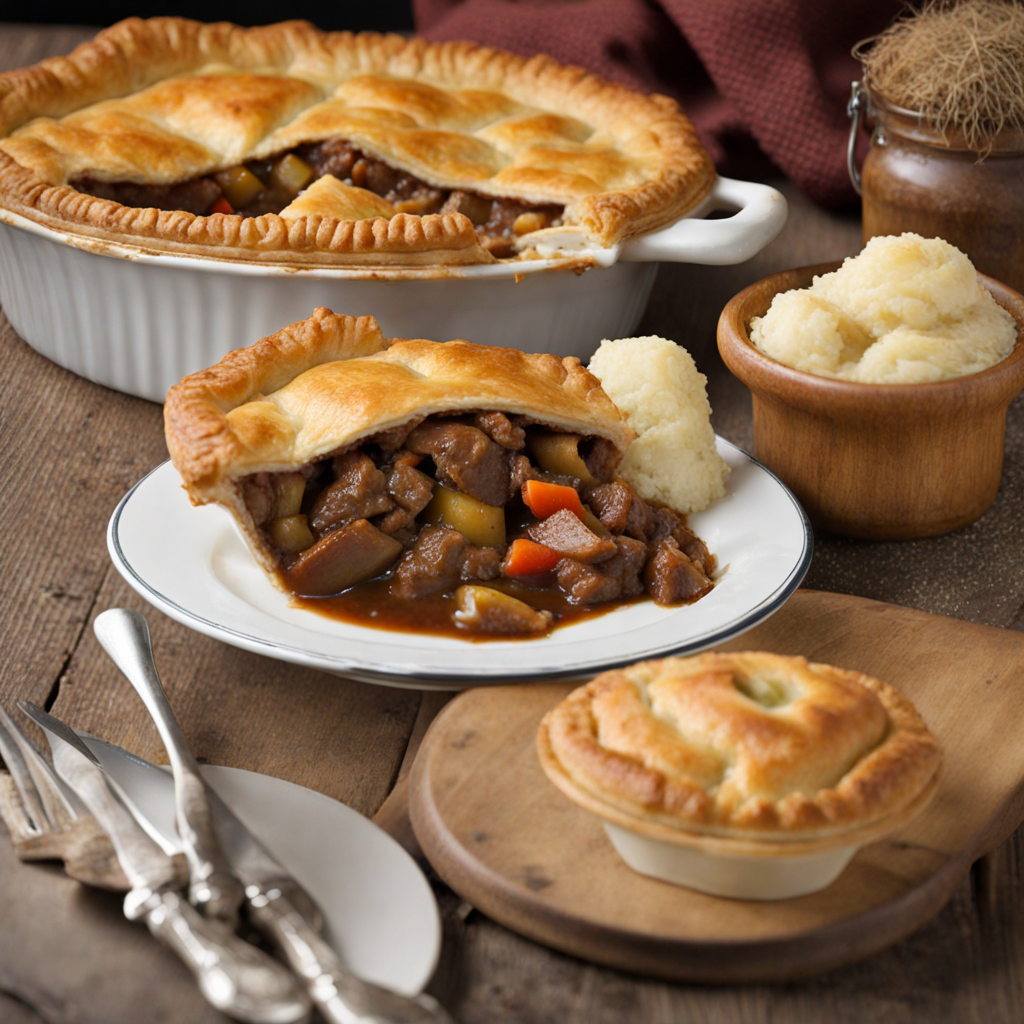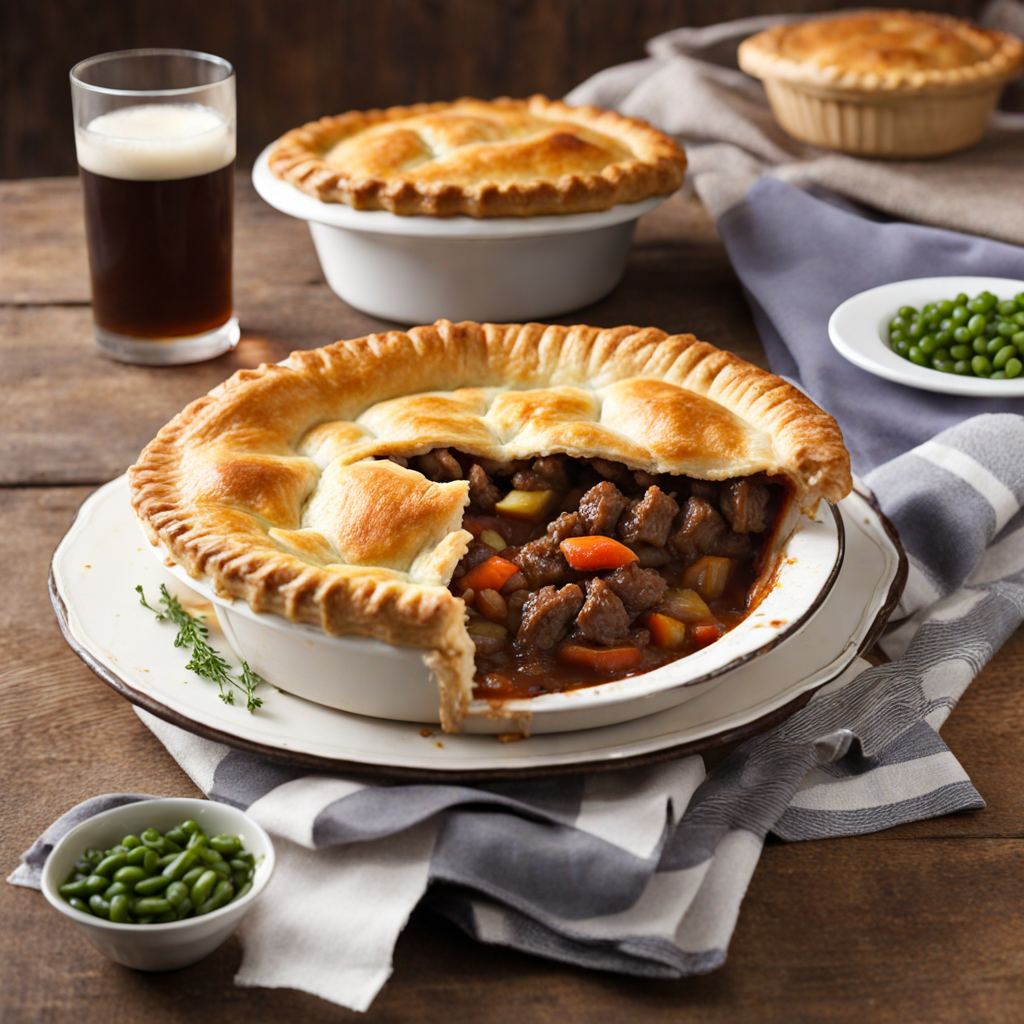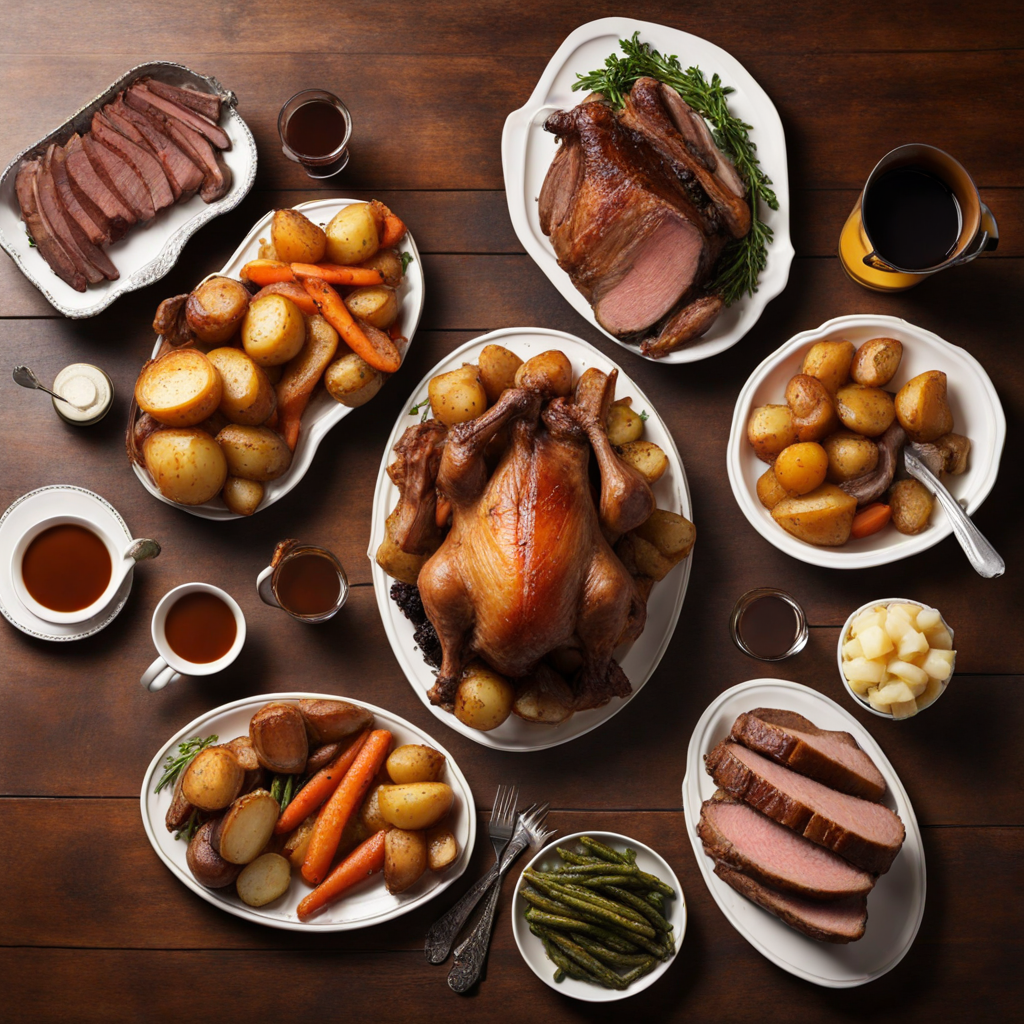Beef and Ale Pie
Beef and Ale Pie is a quintessential dish from the United Kingdom that embodies the heartiness of traditional British cuisine. The pie features tender chunks of beef, which are often slow-cooked to perfection in a rich and flavorful ale-based gravy. This cooking method not only ensures that the meat retains its moisture and tenderness but also allows the flavors to meld beautifully, resulting in a deeply savory filling that is both satisfying and comforting. The use of ale contributes a distinct depth of flavor, often with notes of caramel and malt, making each bite a delightful experience for the palate. Encased in a golden, flaky pastry crust, the Beef and Ale Pie offers a delightful contrast in textures. The pastry is usually made with butter, giving it a rich taste and a light, crisp bite that complements the hearty filling. As you break through the crust, a tantalizing aroma wafts up, inviting you to dig in. This pie is often served with traditional accompaniments such as mashed potatoes, peas, or a side of gravy, which enhances the overall experience and showcases the robust flavors of the dish. What makes Beef and Ale Pie particularly appealing is its versatility; it can be found in cozy pubs, high-end restaurants, and homemade kitchens alike. Each chef or home cook may add their unique twist, such as incorporating herbs, vegetables, or different types of ale, which can vary from a smooth stout to a hoppy pale ale. This adaptability ensures that every serving can bring a new taste experience, making it a beloved comfort food that represents the rich culinary heritage of the UK.
How It Became This Dish
The Rich History of Beef and Ale Pie: A Culinary Tradition of the United Kingdom Introduction Beef and ale pie is a hearty dish that has stood the test of time, encapsulating the essence of British culinary heritage. This traditional pie, filled with tender chunks of beef and infused with rich ale, is not merely a meal; it is a cultural artifact that reflects the historical and social evolution of the United Kingdom. To understand the significance of beef and ale pie, we must delve into its origins, development, and the cultural tapestry it weaves. Origins: Medieval Roots and Early Influences The history of beef and ale pie can be traced back to medieval England. Pies, in general, have been a part of British cuisine since the 12th century, with the earliest references highlighting their practicality. During this period, meat was often encased in a pastry shell to preserve it and make it portable. The concept of using ale, a staple of English life, to flavor meat dishes likely emerged from the brewing traditions that were deeply embedded in society. In medieval times, ale was not just a beverage; it was a vital source of nutrition. It was safer to drink than water, which was often contaminated. As ale became an integral part of daily life, combining it with meat in a pie reflected the resourcefulness of the English kitchen. The use of beef specifically can be attributed to the agricultural practices of the time, where cattle were widely raised for dairy and meat. Cultural Significance: A Symbol of Hearth and Home As the centuries progressed, beef and ale pie evolved from a practical sustenance to a symbol of home and comfort. The dish became a staple in many households, especially during colder months, when the warmth of a pie baking in the oven filled homes with a sense of comfort. It was often served during gatherings and celebrations, becoming a centerpiece in family meals and festive occasions. In the 18th and 19th centuries, the Industrial Revolution brought significant changes to British society. As people moved from rural areas to urban centers, traditional foods like beef and ale pie served as a link to their agrarian past. The pie became associated with working-class culture, as it was hearty and affordable. Pubs began serving beef and ale pie on their menus, further cementing its status as a beloved dish among the masses. Development Over Time: Regional Variations and Innovations As with many traditional dishes, beef and ale pie has undergone regional variations and adaptations over time. Each region of the UK has its own take on the pie, influenced by local ingredients and culinary traditions. For instance, in the North of England, you might find a richer, thicker gravy, while in the South, the pie may be lighter and seasoned with herbs. The use of different ales also varies, with darker ales adding a robust flavor compared to lighter beers. In the 20th century, as the world experienced global conflicts and societal changes, the culinary landscape of the UK began to shift. The post-war era brought about a renewed interest in traditional British dishes, with many chefs and home cooks seeking to revive historical recipes. Beef and ale pie re-emerged as a symbol of national identity and comfort food, representing resilience and continuity amidst change. The rise of gastropubs in the late 20th and early 21st centuries further popularized beef and ale pie. Chefs embraced traditional recipes while infusing modern techniques and gourmet ingredients, elevating the dish to new culinary heights. This resurgence highlighted the versatility of the pie, allowing it to adapt to contemporary tastes while retaining its historical roots. Culinary Craftsmanship: Ingredients and Techniques At its core, beef and ale pie is a dish that celebrates simplicity and quality. The key ingredients—beef, ale, and pastry—must be carefully selected to create a balanced flavor profile. Traditionally, cuts of meat such as chuck or brisket are used, as they become tender when cooked slowly. The choice of ale is equally important; a rich, malty ale enhances the dish's depth, while lighter ales can provide a more delicate flavor. The preparation of beef and ale pie involves several techniques, including braising the beef to develop its flavor and making a shortcrust or puff pastry that envelops the filling. The pastry is vital, serving not only as a vessel but also as a barrier that locks in moisture and flavor. The process of making a pie, from searing the meat to rolling out the pastry, embodies the craftsmanship that has been passed down through generations. Modern Day Relevance: A Dish for All Seasons Today, beef and ale pie remains a cherished dish in the UK and beyond. It is often associated with comfort during colder months, but its robust flavors make it suitable for year-round enjoyment. The popularity of this dish is evident in pubs, restaurants, and homes, where it is frequently featured on menus or served at family gatherings. Moreover, the dish has transcended its historical boundaries, with chefs and home cooks experimenting with different flavors and presentations. Vegan and vegetarian adaptations of beef and ale pie have emerged, using plant-based ingredients to cater to changing dietary preferences. This evolution reflects society's growing awareness of sustainability and health, while still honoring the traditional roots of the dish. Conclusion: A Culinary Legacy Beef and ale pie is more than just a meal; it is a reflection of the British culinary landscape, encapsulating centuries of history, culture, and community. From its medieval origins to its contemporary adaptations, the pie continues to evoke feelings of nostalgia and comfort. As we savor each bite of this classic dish, we partake in a rich culinary legacy that connects us to our past while inviting us to innovate for the future. In a world that is rapidly changing, the humble beef and ale pie stands as a testament to the enduring power of food—a dish that brings people together, tells stories, and celebrates the essence of home. Whether enjoyed in a cozy pub or lovingly prepared in a family kitchen, beef and ale pie will forever hold a special place in the heart of British cuisine.
You may like
Discover local flavors from United Kingdom







